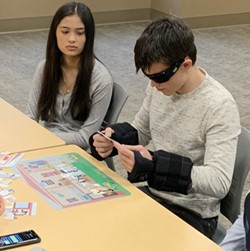Here are our tips and opioid educational tools for starting your program.
 Whether you are designing an opioid abuse prevention program for community members or younger students, these key principles, tips, and tools can help ensure your program is an engaging success. Keep reading for best practices, resources, and more that will walk you through how to start an effective opioid educational program in your community.
Whether you are designing an opioid abuse prevention program for community members or younger students, these key principles, tips, and tools can help ensure your program is an engaging success. Keep reading for best practices, resources, and more that will walk you through how to start an effective opioid educational program in your community.
Before You Begin
Set clear goals and objectives
Knowing exactly what messages or takeaways you want participants to leave with at the end of the program can help you design a more effective curriculum around those learning objectives. Consider using the same philosophy that teachers do with defined, clear objectives that are actionable and achievable.
Find engaging resources and materials
After you set your learning objectives, you can begin to locate all relevant reading material, studies, tools, and other resources that can help inform the content of your opioid prevention program as well as be used during the program itself. Here is a great round-up of opioid abuse-specific resources for program providers that may be useful for you.
Tailor the message to your audience
The messages and tools you use during an opioid abuse educational program will be drastically different when speaking to a group of adults from your community versus young high school students. As such, you should appropriately tailor the content of your program to fulfill the needs and learning levels of your audience. With youth audiences, for example, correcting misperceptions about the prevalence and “normalization” of opioid and other drug use is key.
During the Program
Share real stories and facts
Programs become more engaging and relevant when real stories, statistics, and other material is shared. Personal testimonies from previous opioid users may be compelling, depending on your audience’s ages and risk of substance abuse. Other statistics and data also may have its place in the content of your lesson.
Discover one story of how the Fatal Vision Opioid Goggles helped teens in West Virginia confront addiction on our blog.
Use interactive, hands-on activities
Hands-on participation can instill memorable lessons that participants of your program will not forget anytime soon. We recommend incorporating games and other opioid educational tools to boost engagement and hands-on learning in your lessons.
The Fatal Vision®️ Opioid Goggles are one such tool that helps simulate the various effects of opioid abuse on an individual’s health and wellbeing. When using a designated mobile app alongside specially designed activities, participants can experience the simulated effects of opioid abuse such as nodding out, contrast sensitivity impairment, and lethargy. This kit also comes with an educational DVD, home and school learning activities, in-app educational materials, and germicidal disposable wipes for goggles sanitation.
Learn more about our tools for opioid and drug abuse educational programs here.
Ask for participant input
Getting your audience involved and starting a conversation is critical to the success of your opioid abuse prevention program. Ask participants to share their thoughts in between important lessons. Generating a list of thought-provoking questions before the program begins can be a useful way to get that conversation started if participants are initially reluctant to share.
After the Program
Gather participant feedback
Gathering feedback from participants after the opioid abuse prevention program has ended can help you learn and adapt from the experience. If participants struggled to stay engaged during a particular activity or section, for example, you may want to improve the activity or remove it entirely.
Follow-up as needed
Educational programs do not need to be one-and-done. In fact, sometimes having follow-up sessions days or months later can help continue the conversation and ensure the main objectives of the session have been achieved. Real change of thoughts and attitude takes time – so follow-up with participants as needed to keep your lessons top-of-mind.
These tips, resources, and tools can help you build an opioid abuse prevention program that is effective and engaging for your audience. Browse our full line of alcohol and drug educational tools online or call 800.272.5023 for customized support today.
Related Opioid and Drug Abuse Prevention Articles
Tools for Your Opioid & Other Drugs Abuse Prevention Program
Opioid abuse prevention and other drug abuse educational programs can benefit from engaging tools and experiences that get participants involved and interested in learning.
 4 Tips to Hold A Successful Opioid Abuse Prevention Program
4 Tips to Hold A Successful Opioid Abuse Prevention Program
Opioid abuse prevention should be a critical component of your drug abuse education program. Here are four tips for how to structure an impactful opioid abuse prevention program.




 Whether you are designing an opioid abuse prevention program for community members or younger students, these key principles, tips, and tools can help ensure your program is an engaging success. Keep reading for best practices, resources, and more that will walk you through how to start an effective opioid educational program in your community.
Whether you are designing an opioid abuse prevention program for community members or younger students, these key principles, tips, and tools can help ensure your program is an engaging success. Keep reading for best practices, resources, and more that will walk you through how to start an effective opioid educational program in your community.
